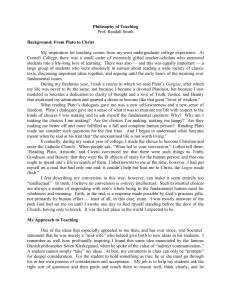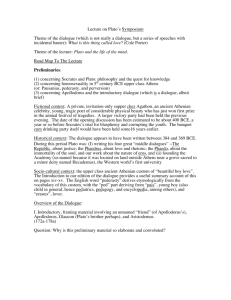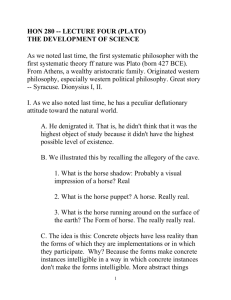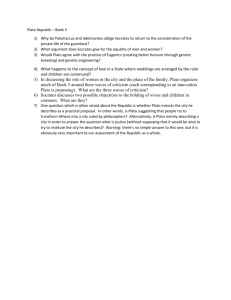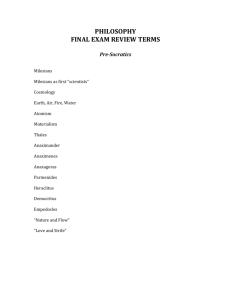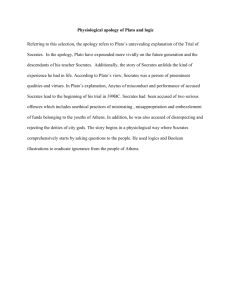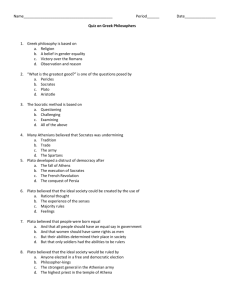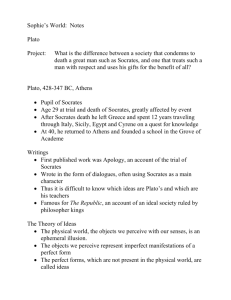The Individual and the Ladder of Love in Plato's Symposium
advertisement
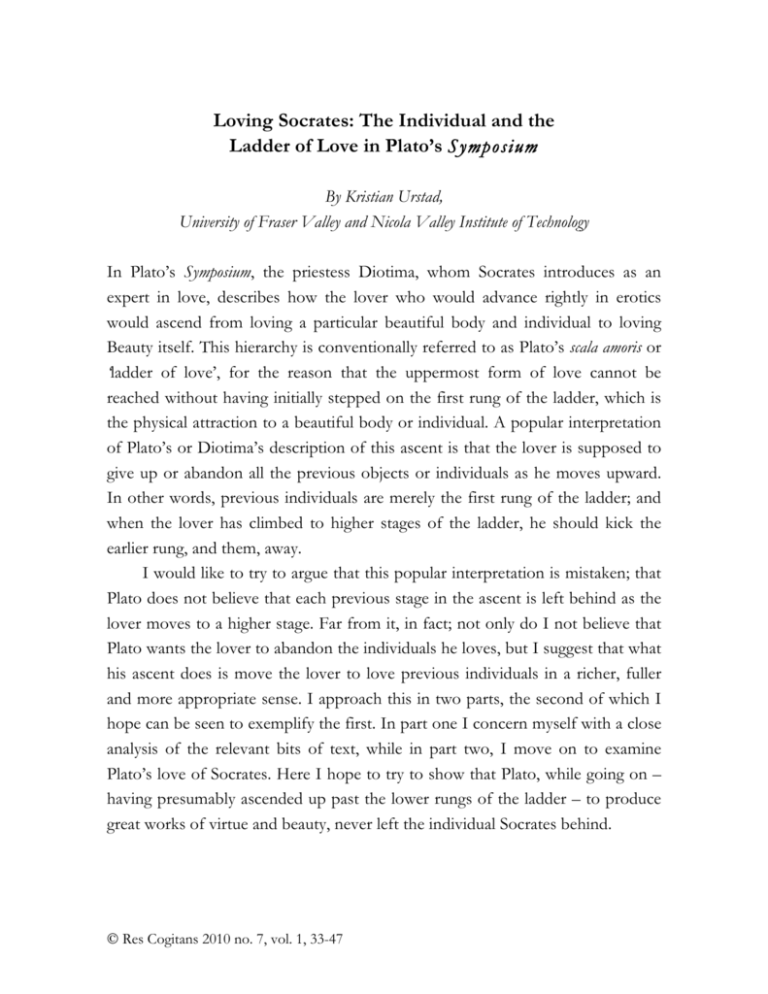
Loving Socrates: The Individual and the Ladder of Love in Plato’s Symposium By Kristian Urstad, University of Fraser Valley and Nicola Valley Institute of Technology In Plato’s Symposium, the priestess Diotima, whom Socrates introduces as an expert in love, describes how the lover who would advance rightly in erotics would ascend from loving a particular beautiful body and individual to loving Beauty itself. This hierarchy is conventionally referred to as Plato’s scala amoris or ‘ladder of love’, for the reason that the uppermost form of love cannot be reached without having initially stepped on the first rung of the ladder, which is the physical attraction to a beautiful body or individual. A popular interpretation of Plato’s or Diotima’s description of this ascent is that the lover is supposed to give up or abandon all the previous objects or individuals as he moves upward. In other words, previous individuals are merely the first rung of the ladder; and when the lover has climbed to higher stages of the ladder, he should kick the earlier rung, and them, away. I would like to try to argue that this popular interpretation is mistaken; that Plato does not believe that each previous stage in the ascent is left behind as the lover moves to a higher stage. Far from it, in fact; not only do I not believe that Plato wants the lover to abandon the individuals he loves, but I suggest that what his ascent does is move the lover to love previous individuals in a richer, fuller and more appropriate sense. I approach this in two parts, the second of which I hope can be seen to exemplify the first. In part one I concern myself with a close analysis of the relevant bits of text, while in part two, I move on to examine Plato’s love of Socrates. Here I hope to try to show that Plato, while going on – having presumably ascended up past the lower rungs of the ladder – to produce great works of virtue and beauty, never left the individual Socrates behind. Res Cogitans 2010 no. 7, vol. 1, 33-47 (1) Let us begin by looking closely at the first three steps of the ladder, as described by Diotima. The first step is for the lover to love one body, the next, to love all beautiful bodies, and the third, to love the beauty that a soul can have (210a-c). During all this, we should take notice that Plato never has Diotima say that a previous individual is left behind during the lover’s ascent. Initially, what she says, when she is speaking of the climb upward along the initial rungs of the ladder – from loving an individual body to the beauty of all bodies – is that, upon realizing that the beauty of all bodies is identical, the lover’s obsession with the previous individual’s body will grow less intense and strike him as small (smikron) (210b, 210c). Several things need to be said about this. First of all, to regard the previous individual’s body as small is not to regard it as nothing at all.i To be sure, the individual’s body is now seen by the lover as far less important, nevertheless, that it has become of small importance to him suggests that it still has some sort of place left in his life.ii This is corroborated by Diotima’s use of the comparative claim that the lover’s obsession for the individual’s body will grow ‘less intense’ as he ascends. Less intensity is still some intensity, however little it may be. Surely, had Plato in mind the complete termination or breaking off of all desire for the individual’s body, he would have had Diotima avoid such comparatives. In other words, if he had wanted Diotima to drive this particular (seemingly crucial) point home – that the previous individual and his body is completely left behind during the lover’s ascent – she would have been made to state it definitively, free from the possibilities that the comparatives allow for.iii We might think then that some small amount of regard for the previous individual’s body remains for the lover even as he ascends to the next rung. There is, moreover, something else we need to take note of in the aforementioned passage. Diotima says that the lover’s infatuation with the previous individual’s body will grow less intense as he ascends but she doesn’t say anything about the state, during this progression, of the lover’s love for that individual as a whole or apart from his body. Her point, at this stage, appears to be a selective one, about the diminution of desire on the part of the lover for this 34 individual’s body. She does not say, in leaving his body largely behind, that, along with it, the rest of him is left behind. It appears to be the intensity for the individual’s body, not the individual himself, which the newly ascended lover looks down on. This suggests then that Diotima allows for the same individual to survive as the object of the lover’s love during these stages of his ascent. In fact, I believe the notion of survival here is severely understated. What I want to suggest is that it is not just that the same individual barely survives the lover’s admiration for him – that with each stage of the ascent comes a corresponding decrease, or thinning out, of the lover’s love for him – but that, conversely, he becomes the object of a stronger, richer, more inclusive love. This is the implication of Diotima’s statement that the lover’s obsession with the previous individual’s body will grow less intense. In freeing himself up of his obsession with the body of his beloved, the lover can now see things about that individual he was never quite able to see before. Prior to his ascent, the lover was fixated on, or preoccupied with – ultimately enslaved by – one particular aspect of the individual, thus clouding and constricting his perception of the totality of the person. Hence Diotima’s presumption here does not seem to be that the lover, once ascended, liberates himself from that individual, but rather, it is that he frees himself from the limited sorts of thoughts he once had about him. Having ascended and so lost his excessive preoccupation with the individual’s body – thinking it now to be of small matter – he will not only become (at once) receptive to all sorts of aspects of the individual that were previously not available to him, but this in turn will awaken in him certain (previously dormant) psychological resources and capacities (beyond those involving mere sexual receptivity to physical beauty), of the sort which will then further serve to open up and enrich his love and appreciation for his beloved.iv Once again, this allows for the possibility that the same individual will remain as the object of the lover’s love during his ascent (having arrived now at the third step: love of a beautiful soul). For even if the flower of youth begins to wilt or fade in the beloved (a reality the Greeks never tired of stressing), he will now, given his latterly recognized inner beauty, still be loved by his lover (210b). 35 The beloved may find that his lover has shed much of his passion for his body, but what he has lost in exclusivity, as the object of the lover’s short-term and sporadic – but no doubt striking – bouts of intensity, he likely gains in endurance and richness of response. So far then, what the first three steps of the ascent appear to have shown us is how the lover comes to love those same individuals in his life fully and appropriately, from a selective, temporary preoccupation or infatuation, to a somewhat deeper, stable, more enduring love. (2) Diotima goes on to describe the final three rungs of the ladder of love. Having come to love mental beauty or beauty of the soul, the lover will then have no choice but to ascend to love beautiful public institutions, laws and activities. He then presses on to the penultimate stage to love the beauty of the sciences or knowledge in general. This is said to finally culminate into a love for Beauty itself (auto to kalon), which Diotima describes as looking upon a vast sea of beauty (210c-d). Now, many commentators have taken these last three stages of the ascent to involve a move entirely away from love of previous individuals and relations between individuals in general. This is because the higher stages here appear to be exclusively concerned with a love of beautiful objects, systems, and abstractions; the love of concrete persons, in its various manifestations, seems to be extant only during the first three stages of ascent.v According to this account then, the lover, having made his way up past the halfway point of the ladder, is no longer thought to be concerned with any of those previous individuals he loved. To be sure, those individuals he once loved figured as important (initial) operative causes in his ascension; however, having now moved upward into the region of objects and abstractions, he is said to find himself quite removed from affection for them. Again, I would like to suggest that, even here, beyond the halfway point of the summit, the lover does not abandon those previous individuals in his life. Perhaps the best way to begin is to attend to a couple of claims Diotima makes which have often been taken as evidence of the view of the lover’s supposed 36 rejection of human objects of love. First, at 210e6, Diotima says that Beauty itself is what all the previous toils or steps were “for the sake of”. Several commentators have taken this to mean that beautiful individuals or objects are valuable only instrumentally, as a mere means to Beauty itself. As such, they are taken to be interchangeable – perhaps ultimately discardable.vi If this is right, it may provide us with further reason to suppose that the lover is meant to drop or give up all previous individuals as he ascends. Second, and not long after, Diotima states that the lover who encounters Beauty itself will be free of “human flesh and colouring and all that mortal rubbish” (211e). Again, the common interpretation here is that the lover, once he has reached the terminus, discards human or mortal objects of love and replaces them with the relevant higher objects.vii Let us first consider Diotima’s “for the sake of” claim. Does it follow from her formulation that beautiful objects and people are to be desired exclusively as a means to the end of Beauty itself? Surely not. In the Republic, Plato acknowledges types of objects (knowledge and health, for example) which we desire both for their own sake and for the sake of what comes from them (357c). Even if we are to understand Beauty itself as the only object that is desired for its own sake alone, this still leaves it open that other beautiful objects and individuals are to be valued for their own sake and for the sake of a further end. In this sense, Plato would have the analytical resources to suggest that the construal of the relationship between a beautiful individual and the final end of Beauty itself may not be a purely causal one, where such an individual is causally conducive to Beauty itself as a means. And if this is the case – if individuals are valued as ends in themselves, and not just purely instrumentally – then they may be in some sense necessary constituents, and so not substitutable or discardable. Diotima’s aforementioned claim at 211e is also not as clear as many take it to be. When she speaks of the lover being free from human flesh and colouring, all she may be inferring is that he who has risen to see Beauty itself will now love his beloved in a greater and more appropriate way because (due to his newly gained insights) he sees what is of value in him. To be sure, Diotima’s claim 37 strongly suggests that the lover, having reached the final stage, no longer values the bodily beauty of his beloved (certainly, at least, bodily beauty tied up with obsession); but, to repeat, the further implication here may be that what the final ascent has given the lover are the sorts of conceptual resources needed to see what is really worth loving in him. If this is the correct inference, Diotima would not be claiming that someone who has seen Beauty itself will come to reject all human objects of love. Can such readings be corroborated by the surrounding text? I believe they can. At 210d, Diotima states that the lover, having faced the vast sea of beauty, will now think the “slavish love” of youthful beauty to be a thing of the past. Notice that what she takes the lover to have discarded is his specifically servant love of a beautiful boy – one characterized and plagued no doubt by physical infatuation or obsession. That is the extent of those things the lover is said to now consider a thing of the past. Additionally revealing is what Diotima says, or more accurately, fails to say, at the summation of her speech. At 211d, she gives a list of all those things someone who has seen Beauty itself would not consider to measure beauty by (and think ultimately to be of no significance). It is here, if anywhere, we would expect some reference to human objects of love. But what we find on that list is gold, clothing and good-looking boys and youths. All that Diotima appears to be criticizing here is the lover’s obsessive desire to look at young boys (which she associates with a fascination with gold and fancy garments). As such, is it not most reasonable to take her as merely elaborating on, or confirming, her earlier critiques of the overvaluing of beautiful bodies due to infatuation? In any case, there is absolutely no mention on her list of fine or beautiful souls, and, correspondingly, never a hint that, having reached the terminus, there is anything suspect in the notion that the lover remains a lover of an earlier soul. (3) It is essential, at this point, to say something about the role of the Form of Beauty in all of this and what the consequences of the lover’s insight into it are. 38 For it is often thought that, having beheld Beauty itself, the lover has nothing further to do beyond contemplating it, beyond continuing to savor his understanding of this supreme object. In other words, it is the lover’s insight itself which is the ultimate goal of the ascent; having achieved this insight, the lover’s quest is complete.viii But do we get this sense of completion or finality when we consider Diotima’s final words to Socrates? Or haven’t you remembered,” she said, “that in that life alone, when he looks at Beauty in the only way that Beauty can be seen – only then will it become possible for him to give birth not to images of virtue (because he’s in touch with no images), but to true virtue (because he is in touch with the true Beauty). The love of the gods belongs to anyone who has given birth to true virtue and nourished it… (211e-212a) Here seeing, or insight into, Beauty appears to be intermediate to the ultimate goal of giving birth to true virtue and nurturing it. In other words, it seems that the real goal of such insight is virtuous living or activity. The implication here is that the lover, having finally gotten sight of Beauty itself, still has much more to do. The ultimate end then looks to have something to do with going on to live in a certain way, in accordance with virtue, in the light shed by the form of Beauty. As I have tried to show, there appears to be little indication in Diotima’s speech that the lover is meant to abandon the individual he loves as he ascends the ladder of love, ultimate rung included. But if the lover’s beloved is, so to speak, still around at this stage of the lover’s progress (loved now, of course, almost entirely for his soul), how exactly are we to understand or characterize this relationship now that the lover has gained insight into Beauty itself? The contrast Diotima draws between giving birth to images of virtue versus true virtue is, I think, suggestive. We know from earlier in her discussion with Socrates that Diotima considers the best form of love between two individuals to be largely educative and philosophical in nature. The lover, pregnant in soul, comes across an attractive mind or soul, a communion which induces him to give birth to beautiful discourse, wisdom and virtue. The lover not only, through education and reasoning, tries to inculcate such qualities in his beloved, but, together, they go on to produce their own philosophical or discursive offspring 39 (209a-c). With a slight qualification, I suggest we continue to see this pedagogical and philosophical aspect at play, even after the lover’s insight into the form of Beauty (after all, this insight, as mentioned, is not an end in itself but spurs further excellent activity). The difference between the two stages is mirrored by Diotima’s distinction between the creation of images of virtue and true virtue. The lover’s earlier efforts to educate his beloved and the sorts of philosophical offspring they produced were partly inadequate or in need of improvement. This was so because at this stage of his ascent the lover did not yet know what Beauty was. However, having beheld that supreme object, he can now beget true virtue; with his new understanding, he can offer his beloved the same vision of absolute Beauty he himself has had and together they can go on to produce and nurture even finer offspring than they had earlier in their relationship. It is, moreover, reasonable to assume that Beauty’s effect will serve to intensify, deepen and further cement their relationship. Not only will they (initially, the lover) be more motivated to converse with each other, but their conversations will be more engaging. They will have more in common – more so than those whose only connection is their joint production of biological children – and so more to share with each other. After all, previously in her discussion, Diotima had hinted as much. At 209c, she states that a similar kind of relationship, one united by discursive offspring, involves a “far stronger bond and far more constant affection”, than one united by ordinary children, and there is no reason to think that the relationship they have now, one linked by the notional children they nurture together in the light of Beauty, will be anything but even more powerful. Diotima also claims, in that same passage, that the lover who has become intimate with his beloved in this discursive way, thinks of his other “all the time, whether or not he’s there”. Again, it would be difficult to believe that the same sort of thoughts do not apply to each partner in their shared vision of Beauty itself and ultimate meeting of minds. I submit then that these two philosophers (for that is what they have become) really do love and care for each other, in a far greater way than they ever have before. 40 (4) In his influential paper, The Individual as the Object of Love, Gregory Vlastos argues that Plato’s theory in the Symposium (expressed through Diotima) is not ultimately about personal love for persons but about love for impersonal objects and abstractions. He states that Plato relegates the love of persons to the lower levels of the ladder only; as objects of Platonic love, persons are distinctly worse than impersonal objects and abstractions, and have no place in the higher stages of the lover’s progress. Vlastos then makes the following claim about Plato’s love for Socrates. Even those two personal attachments which seem to have meant more to him than did any others in his whole life – his love for Socrates in his youth, and, later on, for Dion of Syracuse – would be less than halfway up to the summit in that diagram. (italics added) The suggestion here appears to be that if Plato considered his own love for Socrates in light of the theory of ascent he presents, he would have to regard Socrates as someone who would not survive long as the object of his love. Suppositionally, had Plato, the lover, moved on past the first three rungs of the ladder, Socrates would have been replaced with the relevant higher objects of love. If something like this is Vlastos’ suggestion, is it accurate? Would Plato have left the individual Socrates behind? Before we begin to look for an answer to this question, we might wonder if Plato himself embraces the theory of love he puts into the mouth of Diotima? There is no way to know for sure, since of course Plato never speaks to us directly and in his own voice, and so does not himself affirm any position that is presented in his dialogues. We do however have his Letters, alleged to have been personally written by him. Though most of them are certainly not genuine, many scholars take Letter VII to be the least unlikely to have come from Plato himself. In that letter Plato claims to have gained possession of a certain kind of ultimate knowledge or insight, one rooted in a laborious undertaking and a lifetime of practice. He describes the initial process towards its discovery as a joint pursuit, as one necessarily involving a long-continued intercourse or dwelling together between teacher and pupil. This intercourse, he says, finally leads to a sudden – 41 akin to a light flashing forth when a fire is kindled – insight or truth in the soul of the aspirant (341b-e). It is curious how strikingly consistent this entire description is with the ascent and culminating insight into Beauty itself Diotima is made to recount in the Symposium. According to Diotima, the aspirant, through discursive intercourse with another, moves through a succession of experiences and perceptions of beautiful objects until, finally, he suddenly (exaiphnes – the same word is employed in both works) gains insight into Beauty itself (210e). We might perhaps take this consistency between Letter VII and the Symposium as circumstantial evidence for the former’s authenticity. If so, we may have some reason to think that Plato himself subscribes to something like the theory presented by Diotima in the Symposium. In any case, setting aside what is ultimately an insoluble issue, let us simply speculate. What might we say about Plato’s relationship to Socrates in light of the theory of ascent put forward in the Symposium? Would Plato relegate his love for Socrates to the lower rungs of the ladder only, and so leave any affection and thought for him behind as he moved upward? Before we look into this, it is important to first ask how it is exactly we should understand or characterize Plato’s relationship to Socrates? According to Greek homoerotic custom, it was the older man who was the ‘lover’ (the erastes) and the good-looking younger boy or man (roughly, from puberty to growth of a beard) who was the ‘beloved’ (the eromenos), the object of the lover’s eros. We know that Plato was born in 427 BCE, when Socrates was forty-two years old, and that when he was twenty, he met Socrates for the first time and became part of his small, intimate circle of friends. So if we were to loosely apply such homoerotic roles to Socrates’ and Plato’s relationship, we might think of the sixty-two year old Socrates as the lover and the young Plato as the beloved. In such a case, pregnant in soul, Socrates’ love for the attractive Plato would engender in him the creation of beautiful offspring, virtuous actions, lovely discourses, and the like. But is this what we see, is this the best way to understand the direction and effect of the roles between them? 42 In an attempt to answer this, let us consider the kind of sexual roles Plato appears to assign to Socrates and Alcibiades in the Symposium. Alcibiades was renowned as one of the most charismatic and physically attractive younger men in all of Athens. He himself even speaks of his good looks to the symposiasts at hand (217a). Not unlike the younger Plato (Letter VII, 324b), but to a much further degree, Alcibiades also yearned for the political life and showed incredible promise in this regard. Now, even though Alcibiades was the so-called best catch in Athens during this time, he chose to offer himself to Socrates. Socrates too, professed his love for the desirable Alcibiades (on more than one occasion during this particular evening, and in a few of Plato’s other dialogues). Now one would naturally expect the much older Socrates to take on the role of the lover and Alcibiades the beloved in this relationship. But in fact, Plato has Socrates invert (as he is made to do with much of the typical Greek values), or at least, confuse, their sexual roles. It turns out that it is Alcibiades who – initially, despite himself – becomes overwhelmed by, and desires and needs, the inwardly beautiful Socrates (215b, 216e-217a, 219d, 222a), and who partly wishes, but always fails (216a-b), to give birth to virtuous actions through his love of the beauty of the older man. I suggest we understand the young Plato in a similarly inverted loverbeloved relationship with Socratesix – attracted to the older man because of his perceived inner wisdom and beauty and inspired by him to give birth to virtue. Of course, we know that Plato does not fail, like Alcibiades does, to bear the fruits of Socrates’ inspiration. In Letter VII, he says that having been around Socrates and his subsequent martrydom, he withdrew from his associates of the time and turned to philosophy (something Alcibiades simply could not get himself to do), reflecting on the nature of justice and virtue (326a-b). We know that he opened up his Academy a decade later to teach philosophy or at least pose philosophical problems to be studied. We know he visited Sicily on several occasions in the hopes of reforming that city’s political structure. And we know, of course, that during all of this, he produced numerous works of great art, the dialogues we now possess. It is interesting that all of these effects and 43 productions mirror the succession of offspring Diotima lists in her speech to Socrates. The lover meets an attractive mind and he begets virtue and wisdom. He wants to educate and talk about virtue and what qualities and practices it takes for a man to be good. He then produces the wisdom to manage political affairs and make well-designed laws. And finally, he brings (immortal) works into the world like those brought in by poets like Hesiod and Homer. Perhaps we are to see the Symposium in part as a testimony to its author as a successful Alcibiades. But even if Socrates was at one time an important object of love for Plato, an active source of inspiration that prompted his initial turn to philosophy and set him forth on his creative path, this need not suggest that he continued to be. Perhaps as Plato’s love grew to incorporate higher objects, abstractions and creations, his personal attachment to Socrates waned. As an object of love in the theory of ascent presented by Diotima, it may be that Socrates would have ultimately been assigned a position, to quote Vlastos, less than halfway up the summit. Yet, this, it seems to me, would simply not be the right way to see it. As mentioned, insight into the Form of Beauty engenders further excellent activity, pedagogy and creation. Not only does Plato, assuming some such ascent on his part, go on, through the creation of his dialogues, to inculcate virtue and wisdom to his audience, but he has chosen to use – and in so doing resurrect – Socrates as an integral feature of those works. This of course implies that he has all the while spent time thinking about Socrates, that his old friend has never really left his mind. We might see in this resurrection Plato’s wish, in part, to engage in renewed conversation with his friend, the sort that will bring Socrates to a similar kind of vision that he has had. Moreover, as insight begets further activity, we might also understand Plato to be bringing Socrates back as a dialectical partner of sorts, in pursuit of finer offspring than the two were able to produce together when Socrates was alive and Plato a young man. Given this, we might think their relationship to be more powerful now than it ever was before. Not only do they now have uninterrupted time together but they have that much more to share with one another, that much more to create and nurture. Indeed, it would not be unreasonable to view their relationship as having undergone an important 44 transformation, one escalated to a higher level of love. There is one final point to be noticed in all of this. Plato, through his works, not only immortalizes Socrates, but he does so in tandem with himself. Together they stand, face to face, canonized for all of posterity. We might ask if there is any higher testament to friendship and love than this. It seems to me then that it is perhaps not best to see Plato’s love for Socrates as an example of someone who has abandoned the individual man Socrates on his ascent. If this is true, it may give us further reason to suppose that Plato, in the Symposium, is not presenting a theory which suggests that the lover is supposed to give up or abandon all the previous individuals as he moves upward. Notes i Unfortunately, several (otherwise) excellent translations imply this. Plato, Symposium, by Nehamas and Woodruff (1989), reads that “the beauty of bodies is of no importance” (210c); similarly, Plato, Symposium, by Waterfield (1994), has Diotima say that the lover “comes to regard physical beauty as unimportant”. But again, to conceive of physical beauty as smikron ti, “something small”, does not imply that the lover’s valuation of physical beauty disappears completely. ii At 206c, Diotima says that physical sex between a man and a women is something divine. Whatever we are to make of this exactly, this does not sound like someone who wishes to repudiate the importance of the body altogether. iii Diotima mostly talks to Socrates as if she were the wise, authoritative figure and he a naïve neophyte. Had she intended to communicate the complete extirpation of the body from the lover’s ascent, we might have expected her to state this clearly and unambiguously to her novice student. iv See C. D. C. Reeve, (2006). v Vlastos, (1973), for instance, claims that “Plato signifies their superiority (those impersonal objects and Beauty itself) by placing them in the higher reaches of that escalated figure that marks the lover’s progress, relegating love of persons to its lower levels.” (italics added) vi Vlastos (1973) claims that all previous objects, bodies, and minds are loved “as a means of moving closer step by step” to Beauty itself, and that loving individuals as “ends in themselves” is a thought that “never occurs” to Plato. vii See Vlastos (1973) and Moravcsik (1972). viii In the Phaedo (64aff), Plato appears to intimate something like this. He suggests that the one goal of philosophers is to die so as to be able to contemplate the forms forever. ix Plato is not alone here. One could classify many of Socrates’ devotees as his lovers: Apollodorus, Agathon, Antisthenes, and Aristippus to mention a few. 45 References Moravcsik, J. M. E. (1972). Reason and eros in the ascent passage of the Symposium. In J. P. Anton and G. L. Kustas (eds.) Essays in Ancient Greek Philosophy (pp. 285-302). Albany, NY: State University of New York Press Reeve, C. D. C. (2006). Plato on Eros and Friendship. In H. H. Benson (ed.) A Companion to Plato (pp. 294-307). Malden, MA: Blackwell Publishing Ltd. Vlastos. G. (1981). The Individual as the object of love in Plato. In Platonic Studies, 2nd edn. (pp. 3-42). Princeton, NJ: Princeton University Press 46
